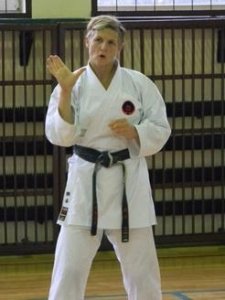Sanchin: The Jewel of Goju-ryu
By: Sensei Linda Marchant – IOGKF England (EGKA)
There have been many articles on Sanchin by instructors who are far more versed in the science of the subject than me. Therefore, I would like to share my views on training for Sanchin and just summarise the various disciplines that you will no doubt be aware of, to help organise your Sanchin journey and begin to appreciate the importance of its existence.
The meaning of Sanchin can be explained as three minds or three conflicts of the mental, physical and spiritual coming together as one, for and by yourself.
I wholeheartedly believe in this moving meditation, the jewel in the Goju-Ryu art that requires an incredible amount of patience, energy and will to perform but that can help in the fight to overcome the 21st century stresses of life in modern society.
To help settle my thoughts on Sanchin I have tried to carve up my thoughts into three principles; Training, Practice and Performance.
- Training – Hojo undo, particularly Nigiri game, fast and slow moving feet, lifting Nigiri game to the side like crane wings, or in front like tiger or bear claws, Chi-ishi Kata, Tetsu Sashi with Kata.
- Practice – Sanchin stepping, Sanchin dachi resistance (belts around the feet pulled by two assistants), Shime, hand resistance both open and closed with a partner, submerge yourself in the sea or swimming pool up to shoulder height for a feeling of resistance, try different breathing lengths and speed.
- Performance – for yourself, for some “me-time”, to perfect your techniques, to understand Kata more deeply, to re-energise.
However, there are the three battles to contend with. I have found my personal interpretation of these as follows:
Mental – to put time aside to practice includes the thought of preparing to put time aside, the time, the after time and your mental state, negative or positive? How committed am I to the practice mentally, are there too many conflicts that should be fought another day? Are there too many things in my head and I need to practice to make some room for me?
Overcoming the mental discussions, sometimes ignoring them sometimes going with them, always with the confidence of my decision, a oneness with myself and the earth, being in the now with every technique, losing the start and the middle and only being at the end. Having stillness in my head.
Physical – the sheer practice of Sanchin is demanding, am I tired, energetic or just lethargic? Have I just eaten or am I too hungry or thirsty? Have I an injury or just a bit stiff and sore from a previous training? What facilities have I got to use or is this a performance only session?
Then the practice- you need only a very small space, the smoothness of the feet on the surface of the floor, squeezing of the fists, the inflation of muscles, the rooting of the feet and focus of the breathing from the Tanden, relaxation of the throat. Afterwards there is an initial feeling of weightlessness when the muscles deflate and then only a little time later maybe some stiffness in the calves, shoulders and lats from the continued tension and perhaps some soreness from Shime!
Spiritual – Determination, being at peace with yourself and all others, the feat of practice against the odds and winning against the conflicts. Preparation to take yourself to different levels of practice for Kata acceptance of the hardship, endurance, the sheer love of training, the hardness of the body and softness of the technique? Being part of the art, having a connection to the roots in China and ultimately the Bubishi and India.
So what does this all mean to me and you?
In the pursuit of perfecting the art of Goju Ryu, this precious Kata must be at the heart of our training. We all have access to it but perhaps only get it out occasionally, look at it and put it back. The more I practice, the more that I believe that I understand Higaonna Shihan’s edict of practicing Sanchin every day. You almost need ‘mushin’ (no mind) to accept Sanchin and that is also a training journey unto itself!
In overcoming the stresses of balancing your work/home life, Sanchin is a unisex, cross-cultural me-time. I say that because ‘me-time’ means different things to different people. From a hot scented bath with favourite background music, to x-box time, to sitting on a beach looking out to sea, or a mountain or a desert. We cannot always obtain these perfect personal scenarios, but we can come very close to surpassing the final experience with Sanchin or Tensho. A calming of the mind, a workout for the body and a better understanding of yourself, in terms of capability and execution of the technique, for me completes the set towards fulfilment.
Of course those experts in yoga will also agree that this concept is not unique, because yogi’s have been practicing their own form of Sanchin for centuries via their postures. As a result they are ahead in understanding the benefits of controlling the breath and using the Tanden.
Therefore, as Karate exponents, we have some catching up to do and in modern times. The biggest threat and risk to our art is that the deep understanding and practice of Sanchin and Tensho is neglected. I see it as a shared responsibility by all Goju-ryu practitioners to assure that the jewel is always on display, even as a dull shape to start, it is regularly polished until you can see the right cut on the outside and the shine from within.
So if you have a minute, practice Sanchin!!

